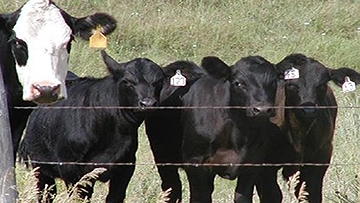Bovine Spongiform Encephalopathy

Bovine spongiform encephalopathy (BSE), widely referred to as “mad cow disease,” is a progressive and fatal disease of the nervous system in cattle. It results from infection by a "prion," an abnormal cellular protein found mostly in the brain. BSE is not contagious. Cattle become infected by eating prion-contaminated feed.
BSE is rare, occurring at a rate of less than one case per million cattle worldwide. However, it's a reportable animal disease. It also presents a public health concern because of its link to cases of variant Creutzfeldt-Jakob disease in people.
The World Organisation for Animal Health classifies the United States as "negligible risk" for BSE. This is based on our country’s history with the disease (only seven cases from 2003 to 2023), control measures in place, and robust BSE surveillance system.
Cattle affected by BSE experience progressive degeneration of the nervous system. Signs usually don't appear until about 3–6 years after initial infection.
Here's what to look for:
- Changes in temperament (nervousness or aggression)
- Abnormal posture
- Coordination problems and difficulty in rising
- Weight loss
- Decreased milk production
- Loss of condition without noticeable loss of appetite
After signs appear, the animal’s condition deteriorates until it dies. This usually takes anywhere from 2 weeks to 6 months.
BSE exists in two forms: classical (C-type) and atypical (L-type or H-type). They don't spread through casual contact between animals.
Classical BSE spreads via feed that contains meat-and-bone meal or other proteins from infected cattle. Standard rendering processes don't completely inactivate the prion, an infectious, abnormally formed cellular protein.
The United States has regulations in place that prohibit the feeding of most animal proteins to cattle and other ruminants (hoofed animals). We also prohibit all specified risk material, which could harbor BSE, from being included in animal feed. Specified risk material includes brains and spinal cords from animals 30 months of age or older. These feed bans are the most important measure to prevent BSE transmission.
Atypical BSE isn't associated with contaminated feed. In 2015, the World Organisation for Animal Health determined that it occurs spontaneously at a low rate in all cattle populations and would be excluded for BSE risk. Of the seven U.S. cases from 2003 to 2023, the first was a case of classical BSE that was imported from Canada; the rest were atypical BSE.
There's no vaccine or treatment for BSE.
Report Signs of Animal Disease
Producers or owners who suspect an animal disease should contact their veterinarian to evaluate the animal or herd. Find an accredited veterinarian.
Animal health professionals (veterinarians; diagnostic laboratories; public health, zoo, or wildlife personnel; and others) report diagnosed or suspected cases of nationally listed reportable animal diseases to APHIS Area Veterinarians in Charge and to the State animal health official as applicable under State reporting regulations.
Controlling Bovine Spongiform Encephalopathy
The only classical BSE case identified in the United States was in 2003 in a cow imported from Canada. Since then, six cases of atypical BSE have been found. The last one was in 2023.
The United States has strong measures in place to protect animal health and public health from BSE. APHIS works with USDA's Food Safety and Inspection Service and the U.S. Food and Drug Administration to maintain these measures. They include:
- Prohibiting mammalian meat-and-bone meal from being included in animal feed
- Banning specified risk materials (brain and spinal cord tissues) from our food supply, animal feed, or other products
- Destroying animals that show signs of BSE and animals that are associated with BSE positive cattle according to WOAH guidelines
- Banning cattle that can't stand or walk from the human food chain
- Prohibiting air-injection stunning of slaughter cattle
- Requiring additional process controls in advanced meat-recovery systems
- Forbidding the use of mechanically separated meat in human food
We also maintain trade restrictions that prevent BSE from entering the United States through imports. Our regulations are consistent with World Organisation for Animal Health guidelines and allow safe trade in many bovine commodities, including meat.
Lastly, we have a robust BSE surveillance program (789.28 KB). This program has been in place for decades. It targets cattle populations with the highest probability of BSE detection: animals with symptoms of BSE and cattle 30 months of age or older that are non-ambulatory, recumbent, or unable to rise or walk without assistance.
Surveillance Testing
Cattle showing symptoms of central nervous system disease are especially valuable to the BSE surveillance program. Accredited veterinarians with proper training can play a key role in sampling these animals.
Additional information can be found in the National BSE Surveillance Plan (789.28 KB) or by contacting your nearest APHIS Veterinary Services office.
Carcass Disposal
The preferred method for disposing of BSE-infected carcasses is alkaline digestion or complete, high-temperature incineration. Under no circumstances should BSE suspects be used for human or animal consumption.
Etiology
BSE belongs to a family of diseases known as transmissible spongiform encephalopathies that includes, among others, scrapie in sheep and goats; chronic wasting disease in deer, elk, and moose; and classic and variant Creutzfeldt-Jakob disease in people.
- BSE Factsheet (337.61 KB)

